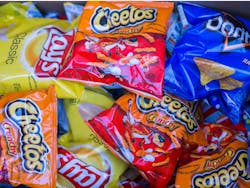California Awards $3.5 Million for Microgrid at Frito-Lay Food Processing Plant
The California Energy Commission has awarded Frito-Lay a $3.5 million grant to build a solar-powered microgrid at a food processing facility in a project the agency is touting as a model for the industry.
The microgrid will be installed at a snack food processing facility in Rancho-Cucamonga, California, to reduce greenhouse gas emissions and to allow the plant to keep running during power outages.
SunPower will provide the project’s solar equipment and microgrid controller while Tesla will supply the project’s energy storage component, according to the CEC, which approved the grant Nov. 10.
The solar panels are expected to produce about 3,500 MWh a year, reducing greenhouse gas emissions by about 850 metric tons annually. The battery system will be able to supply the plant’s critical load for up to six hours before needing to be recharged.
CEC sees microgrid as industry model
“By implementing a microgrid at a food processor, this project will demonstrate the benefits of renewable energy production and electricity reliability to other industrial customers, as well as the benefits of microgrid technology more broadly to utilities and other involved parties,” Kevin Uy, a CEC staff in the agency’s energy research and development division, said in a memo supporting the grant.
Microgrids can help food production facilities deal with planned and unplanned power outages, which can lead to significant financial and product losses, Uy said during the meeting when the commission unanimously approved the grant.
Also, solar microgrids provide a renewable alternative to backup diesel generators, according to Uy.
The battery storage component provides customers with cost savings and resiliency while supporting the grid through strategic charging and discharging, Uy said.
Although microgrids and battery storage can allow industrial facilities to cut their peak demand and protect themselves from power outages, the technology has not been widely adopted because of the specialized engineering required to implement them and the risk of large capital projects with uncertain returns, Uy said in the memo.
Frito-Lay told the CEC the project will reduce its grid purchase at the facility by 15% a year.
One of the key lessons from the project will be how to install a microgrid at a facility that operates around the clock, according to Janea Scott, CEC vice chair.
“The ability to take this and replicate it across the industry is huge,” Scott said.
Frito-Lay, a PepsiCo division, told the CEC the project will reduce its grid purchase at the facility by 15% a year.
The project supports PepsiCo’s goal of running all its operations with renewable energy by 2030 and having its franchised and third party owned facilities use only renewables a decade later.
CEC plans addition food production RFP
The CEC is preparing to issue a $7 million solicitation later this month to fund drop-in energy technologies at food production facilities, Uy said. Information about the grant opportunity will be made available on the CEC website.
The grants are part of the CEC’s Food Production Investment Program, which receives funding through California’s greenhouse gas cap-and-trade program. California is the largest US food producer with 5,730 facilities.
The program has awarded $111 million to 45 projects that are expected to cut greenhouse gas emissions by 152,000 metric tons a year, according to Uy.
Have questions about microgrids? Join us for Ask Me Anything at Microgrid 2020 Global November 18. Representatives from industry, healthcare and education will tell you about their experience with microgrids. Registration is free, but only until November 16.
